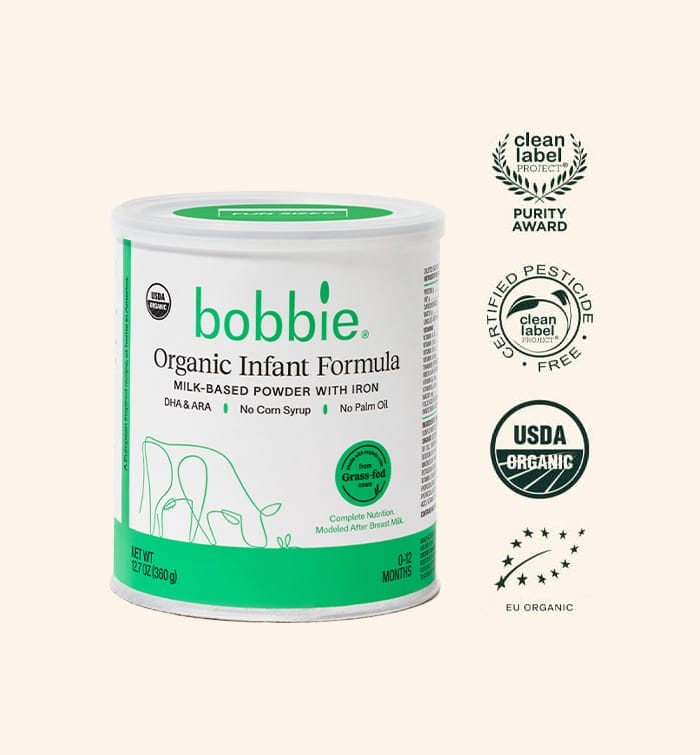We are proud to say that these posts are not sponsored. Our editorial team of Bobbie moms and writers personally select each featured product. If you buy something through our links, we may earn an affiliate commission, at no cost to you.
Walking down the formula aisle can be a bit overwhelming – there are so many different infant formulas available, each with their own labels and ingredient lists. If your head spins just thinking about all the details of infant formula, you’re not alone! But let’s break down one nutrient to try and simplify it: protein.
In order to better understand this nutrient, let’s take a look at whey and casein, which make up the protein component of most routine infant formulas.
Protein often gets a lot of attention in the world of infant formula. And yes, there are many protein options in various formulas: cow’s milk-based, soy, hydrolyzed, and on and on. But before you go there, know this: unless your baby’s doctor has recommended a specialty infant formula, a routine formula that provides whey and casein will likely be well-tolerated by your little one.
Let’s review how whey and casein are both similar and different, the different ratios among different milks, and the most important facts to remember.
What are whey and casein?
Whey and casein are two different types of protein. They’re the sources of protein found in both breast milk and cow’s milk, as well as the milk of any other mammals.1 This is why they’re the protein sources in routine infant formulas.
As we explore these two protein types, there’s one key concept to keep in mind: although both human and cow’s milk contain whey and casein protein, the actual whey and casein proteins in each type of milk are quite significant different. While it makes some sense for infant formulas to mimic the whey and casein ratio of breast milk, protein is more complex than just ratios! The finer details of the composition of different types of whey and casein, as well as how they function in the body, are also considered when infant formulas are designed.
Infant formula manufacturers consider all of these elements, so be assured that each product is carefully designed with the health and nutrition of your baby in mind.
Whey and casein: what are the similarities?
Both whey and casein are considered high-quality proteins2 and provide all nine essential amino acids3 required to support growth and development.
Each of these proteins also has a high biological value, which is a measurement of the amount of nitrogen retained from the protein. Their biological value4,5 makes them appropriate for use as main protein sources in infant formula. Appropriately, whey and casein are trusted sources of protein in many infant formulas.
How are whey and casein different?
Whey and casein are made up of many individual components, and this is where they start to differ. For example, the primary whey fraction in human milk is called alpha-lactalbumin, while the primary whey fraction in cow’s milk is a protein called beta-lactalbumin.6
They also differ in how they function as well as their biological purpose. While a good deal of what we know about whey and casein protein comes from research in adults2 and animals,7 some of these learnings help us understand how these proteins might behave in infants.8
Whey protein has been shown to be critical for increasing muscle protein,2 possibly due to its high concentration of branched chain amino acids. On the other hand, casein9 plays a role in binding calcium and phosphorus,10 which may help the body use these important minerals to build healthy bones. Each protein type plays a role in overall health and development.

Shop Bobbie Organic Infant Formula
Bobbie Organic Infant Formula is a USDA Organic, EU-style infant formula that meets all FDA requirements. It is a complete nutrition milk-based powder modeled after breast milk and is easy on tummies. It is non-GMO and doesn't have corn syrup, palm oil, or maltodextrin. Learn more about Bobbie.
Let’s talk ratios of whey to casein
In human milk, the ratio between whey and casein is dynamic, and it shifts throughout the course of lactation. In the very early days of milk production, breast milk will have more whey than casein, with a whey:casein ratio of 80:20. After the first few weeks of life, the concentration of whey declines and casein increases11 until the proteins reach the concentration seen in “mature” breast milk with roughly equal amounts of each protein type, about 60% whey and 40% casein.12
On the other hand, casein is the dominant protein in cow’s milk, contributing roughly 80% of the protein, while whey makes up about 20%.12
As stated above, there isn’t necessarily a magic whey:casein ratio. Yet, each of these proteins behave differently in the GI tract. This brings us to our next question…
Are whey and casein in infant formula digested differently?
There is much discussion on the digestibility of whey vs. casein.13 Overall, whey remains a liquid during the course of digestion, while casein forms curds or clots. The pH (or acid level) of the stomach influences how these different proteins behave in the GI tract.
The high proportion of casein in unmodified cow’s milk is one of the reasons why regular milk is not an appropriate feeding option for infants. Even after birth, the GI tract still has a lot of maturing to do, and a feeding that provides primarily casein may not be well-tolerated by most infants.
While these proteins definitely possess different physical properties, the reality is that the use of both of these two proteins in infant formulas have been shown to support normal growth and development in countless infants.
For infants who require a special infant formula because of prematurity, a medical diagnosis, or a GI disease, formulas that alter the structure and/or ratio of the whey and casein may be necessary.14
Let’s review the key points of whey and casein:
- Milk protein (human, cow, or any other mammal) is made of whey and casein. Both of these proteins are complete proteins, have a high biological value, and support growth and development.
- There are differences between human and animal milks that go well beyond the ratio of whey:casein – like the composition and functionality of the various proteins.
- The ratios of whey:casein vary in breastmilk, but mature breastmilk is typically 60:40. Cow’s milk protein has a whey:casein ratio of close to 20:80.
- Specialty formulas for babies with medical diagnoses often alter the ratio and/or composition of the protein. But most healthy infants will tolerate a formula with both whey and casein well.
- All babies are different, and your little one will tell you if she’s happy with what she’s drinking! Speak to your pediatrician if you have any concerns or questions.

Shop Bobbie Organic Infant Formula
Bobbie Organic Infant Formula is a USDA Organic, EU-style infant formula that meets all FDA requirements. It is a complete nutrition milk-based powder modeled after breast milk and is easy on tummies. It is non-GMO and doesn't have corn syrup, palm oil, or maltodextrin. Learn more about Bobbie.
Sources:
- Milk Casein Proteins: Ancient, Diverse, and Essential | International Milk Genomics Consortium
- Effect of protein/essential amino acids and resistance training on skeletal muscle hypertrophy: A case for whey protein | Pubmed
- The importance of alpha-lactalbumin in infant nutrition | Pubmed
- Bovine milk in human nutrition – a review | Pubmed
- Energy and protein requirements: report of a Joint FAO/WHO ad hoc expert committee | World Health Organization
- Pediatric Nutrition, 8th Edition [Paperback] | American Academy of Pediatrics
- Whey Versus Casein as a Protein Source during the Weaning Period: Impact on Growth and Later Adiposity and Glucose Homeostasis in a Rat Model of Intrauterine Growth Restriction | Pubmed
- Milk and growth in children: effects of whey and casein | Pubmed
- The Effect of Casein Phosphopetides on Zinc and Calcium Absorption from High Phytate Infant Diets Assessed in Rat Pups and Caco-2 Cells | Pediatric Research
- Physicochemical Characterization of Casein Phosphopeptide-Amorphous Calcium Phosphate Nanocomplexes* | jbc.org
- Protein Content of Human Milk, from Colostrum to Mature Milk | Nestle Nutrition Institute
- Human milk vs. cow’s milk and the evolution of infant formulas | Nestle Nutrition Institute
- Review of Infant Feeding: Key Features of Breast Milk and Infant Formula | National Institutes of Health
- Formula and Infants | Mott Children’s Hospital

